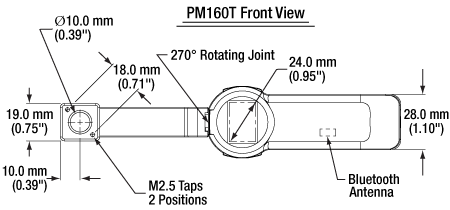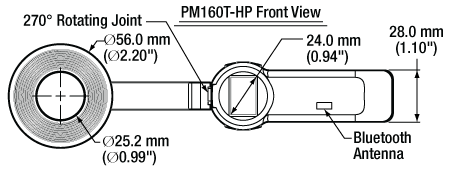
Wireless, Handheld Power Meters

- Self-Contained Sensor and Power Meter with Built-In Graphical Display
- Si Photodiode and Thermal Sensors Available
- Rotating Sensor Arm for Measurement Flexibility
- Bluetooth and USB for Remote Operation
SM1-Threaded Adapter
for the PM160T
Sliding Neutral
Density Filter
PM160T
Power Meter with High-Sensitivity Thermal Sensor
PM160 Photodiode Sensor
and Power Meter with Built-In
OLED Display
Sensor Arm
Rotates 270°
PM160T-HP
Power Meter with High-Power Thermal Sensor
SM1-Threaded Adapter for the PM160T-HP
OVERVIEW
| Table 1.1 Wireless Handheld Power Meter Selection Guide | |||
|---|---|---|---|
| Item # | PM160 | PM160T | PM160T-HP |
| Sensor | Photodiode | Thermal | Thermal |
| Wavelength Range | 400 - 1100 nm | 190 nm - 10.6 µm | 190 nm - 20 µm |
| Power Detection | 10 nW - 2 mWa | 100 µW - 2 W | 10 mW - 70 Wb |
Video 1.2 This animation shows some of the many ways that the PM160 power meter can be oriented. The PM160T and PM160T-HP power meter shares the same post-mounting and sensor-rotation features, but does not include a sliding ND filter.
Features
- Self-Contained Sensor and Power Meter Combination
- Three Power Meters Available (See Table 1.1 for Key Specifications)
- Sensor Arm Rotates up to 270°
- Up to 20 Hours of Battery-Powered Operation and USB Cable is Provide for Recharging
- Graphical OLED Display for Local Operation
- Supports Remote Operation
- Recalibration Services Available
Thorlabs' Wireless Power Meters consist of an ultra-slim sensor connected to a portable power meter with a built-in graphical Organic LED (OLED) display. Versions are available with either a silicon photodiode (Item # PM160), thermal sensor (Item # PM160T), or high-power thermal sensor (Item # PM160T-HP). A rechargeable battery provides up to 20 hours of continuous operation and these power meters can be recharged through the USB port.
The PM160 power meter contains a sensitive silicon photodiode designed to detect optical powers between 10 nW and 2 mW at wavelengths between 400 and 1100 nm. The PM160 also comes with sliding neutral density filter that increases the maximum measurable optical power from 2 mW to 200 mW. The unit automatically detects the position of the neutral density filter to display the correctly calibrated power measurement. To use the filter, simply slide it up the handle until it locks into place over the detector.
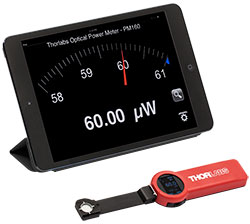
Click to Enlarge
Figure 1.3 The wireless power meter, shown here with an iPad mini™ mobile device (not included), can be remotely operated using Apple mobile devices.
| Power Meter Selection Guide |
|---|
| Sensors |
| Photodiode Power Sensors |
| Thermal Power Sensors |
| Thermal Position & Power Sensors |
| Pyroelectric Energy Sensors |
| Power Meter Consoles and Interfaces |
| Digital Handheld Consoles |
| Analog Handheld Console |
| Touchscreen Handheld Console |
| Dual-Channel Benchtop Console |
| USB Interfaces with External Readout |
| Complete Power Meters |
| Power Meter Bundles |
| Wireless Power Meters with Sensors |
| Compact USB Power Meters |
| Field Power Meters for Terminated Fibers |
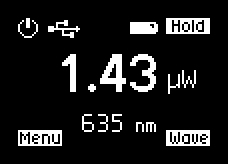
Figure 1.4 OLED Standard Measurement Display
The PM160T power meter uses the same thermal detector as our S401C High-Sensitivity Thermal Sensor Head. This power meter is designed to detect optical powers between 100 µW and 2 W at wavelengths between 190 nm and 10.6 µm. The PM106T-HP, on the other hand, is designed to detect optical powers between 10 mW and 70 W at wavelengths between 190 nm and 20 µm, offering a longer range and higher maximum power. Compared to photodiode sensors, these thermal sensors offer almost flat absorption curves, making them ideal for broadband power measurements. Combined with a wavelength range that extends into the mid-IR, the PM160T and PM160T-HP are well suited for use with a wide variety of sources including LEDs, SLDs, and mid-IR quantum cascade lasers.
These wireless power meters can fit into tight spaces and pick up an incident beam from any direction. The ultra-slim sensor end of the device connects to the handle with a joint mechanism that allows 270° of rotation (see Video 1.2). When rotating the sensor arm, there is a detent every 90° and enough friction in the joint mechanism that the sensor arm can be positioned at any angle within the allowed rotation range.
The output of the sensor is converted to a calibrated optical power measurement that can be displayed on the built-in OLED screen (see Figure 1.4). The power meter can be controlled locally by the four buttons located on the sides of the OLED display's housing. The function of each button is indicated by the labels at each corner of the screen. The menus on the OLED display can also be used to rotate the text in 90° steps for ease of reading.
Alternatively, data can be transmitted using Bluetooth wireless technology or USB to an external device (see Figure 1.3). The wireless power meter can be operated from mobile devices; both Apple® and Android apps are available from their respective app stores.
Recalibration Services
Recalibration services are available for our handheld power meters. All of the sensors and power meters on this page come with a manufacturer calibration by default, but we also offer an ISO 17025 accredited calibration for some items. For more information on calibration options, please see the Recalibration tab or the calibration sections at the bottom of this page.
The Bluetooth® word mark is a registered trademark owned by Bluetooth SIG, Inc. and any use of such marks is under license. Other trademarks and tradenames are those of their respective owners. Android is a trademark of Google Inc. IOS is a registered trademark of Cisco in the U.S. and other countries and is used under license. App Store is a service mark of Apple Inc. iPad mini™ is a registered trademark of Apple Inc.
SPECS
| Item # | PM160 | PM160T | PM160T-HP |
|---|---|---|---|
| Sensor Properties | |||
| Wavelength Range | 400 nm – 1100 nm | 190 nm - 10.6 µm | 190 nm - 20 µm |
| Optical Power Measurement Range | 10 nW – 2 mW (1 µW to 200 mW with Filter) |
100 µW – 2 W | 10 mW - 70 Wa |
| Optical Power Resolution | 100 pW (10 nW with Filter) |
10 µW | 1 mW |
| Measurement Uncertainty | ±3% (451 nm - 1000 nm) ±5% (Over Rest of Range) |
±3% (@ 1064 nm) ±5% (Entire Range) |
±3% (@ 1064 nm) ±5% (250 nm to 17 µm) |
| Power Linearity | ±1% | ||
| Active Area Uniformity | ±1% | ||
| Slideable Optical Filter | Reflective ND (OD 1.5) with Diffuser | N/A | N/A |
| Average Power Density (Max)b | 1 W/cm² (20 W/cm² with Filter) |
500 W/cm² | 2 kW/cm² |
| Sensor Aperture | Ø9.5 mm (Ø0.37") | Ø10 mm (Ø0.39") | Ø25.2 mm (Ø0.99") |
| Sensor Coating | None | Black Broadband | High Power Broadband |
| Power Meter | |||
| Built-In Display | Monochrome White OLED; 24.0 mm (0.95") Across Diagonal, 96 pixels x 64 pixels (10 Hz Refresh Rate) | ||
| Local Operation | 4 Push Buttons | ||
| Analog Measurement Rangesc | 500 nA, 50 µA, 5 mA | 1.6 mV, 25 mV, 400 mV | 2.56 mV, 16 mV, 100 mV |
| AD Converter | 24 Bit | ||
| Analog Amplifier Bandwidth | 10 Hz | ||
| Remote Interface | USB 2.0, Bluetooth (Class II) | ||
| Power Supply | External: 5 V DC via USB; Internal: LiPo+ 380 mAhd | ||
| Battery-Powered Operation | Up to 20 Hours | ||
| Dimensions | |||
| Thickness of Sensor End w/o Filter | 3.5 mm | 5.5 mm | 13.0 mm |
| Thickness of Sensor End w/ Filter | 6.0 mm | N/A | N/A |
| Distance to Sensor from Front Surface of Housing | 1.7 mm (4.2 mm with Filter) | 2.6 mm | 4.5 mm |
| Overall Dimensions | 172.7 mm x 36.4 mm x 13.0 mm (6.80" x 1.43" x 0.51") |
172.7 mm x 36.4 mm x 13.0 mm (6.80" x 1.43" x 0.51") |
206.0 mm x 56.0 mm x 13.0 mm (8.1" x 2.2" x 0.51") |
| Weight | 60 g | 60 g | 130 g |
| Mounting | |||
| Adapter Plate Aperture Thread | External SM05 (0.535"-40) | External SM1 (1.035"-40) | Internal SM1 (1.035"-40)e |
| Mounting Holes | 8-32 and M4 Tap, 3 Positions | 8-32 and M4 Tap, 3 Positions | 8-32 and M4 Tap, 3 Positions 4x 4-40 Tapped Holes on Back of Sensor for Ø6 mm Cage Rods |
| Operating Temperature | 0 to 50 °C (32 to 122 °F) | ||
GRAPHS
Figures 3.1 through 3.3 show the typical response and absorption curves for the handheld power meters. The blue-shaded regions in the graphs indicate the specified wavelength range of the power meter. Please note that these curves are representative, and the actual absorption across the spectrum will vary from unit to unit. Raw data for the graphs are available for download; however, each individual power meter is calibrated to accurately convert the detected signal to the displayed power reading, and a unit-specific calibration certificate is included with each power meter for reference.

Click to Enlarge
Click Here for Raw Data
Figure 3.3 Typical absorption curve for the thermal sensor in the PM160T-HP.
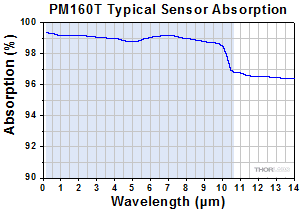
Click to Enlarge
Click Here for Raw Data
Figure 3.2 Typical absorption curve for the thermal sensor in the PM160T.
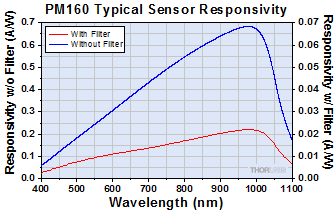
Click to Enlarge
Click Here for Raw Data
Figure 3.1 Typical responsivity curve for the silicon photodiode in the PM160.
SOFTWARE
Compatible Power Meters
- Consoles:
- PM100A Analog Power and Energy Meter Console
- PM200 Legacy Touch Screen Power and Energy Meter Console
- PM100D Legacy Digital Power and Energy Meter Console
- PM100D2 and PM100D3 Digital Power and Energy Meter Consoles (Version 7.0)
- PM400 Capacitive Touchscreen Power and Energy Meter Console
- PM5020 Dual-Channel Benchtop Optical Power and Energy Meter Console (Version 4.0 or Later)
- Complete Power Meters:
- PM160, PM160T, and PM160T-HP Wireless Handheld Power Meters with Bluetooth® Technology
- PM16 Series Compact USB Power Meters
- PM60 and PM61 Fiber Optic Power Meter Series (Version 6.0 or Later)
- Interfaces:
- PM101 Series Power Meter Interfaces with External Readout (Version 2.0 or Later)
- PM102 Series Power Meter Interfaces with External Readout (Version 2.1 or Later)
- PM103 Series Power Meter Interfaces with External Readout (Version 3.0 or Later)
- PM100USB USB Interface Digital Power and Energy Meter
Other Compatible Devices
- ERM2xx Series Extinction Ratio Meters
- SPCNT Single Photon Counting Device
- TSP01 USB Temperature and Humidity Data Logger
- TSP-TH Additional Temperature Probe
- WM202 Wavelength Meter
Optical Parameter Monitor
The Optical Parameter Monitor GUI software features readout from up to eight power meters or other compatible devices, or remote wireless operation.
For details on specific software features, please see the user manual.
Users interested in the legacy Power Meter Software can find it by visiting the software page.
The PM100D2 and PM100D2 are only compatible with version 7.0. The PM101 Series Power Meters are only compatible with version 2.0 or later. The PM102 Series Power Meters are only compatible with version 2.1 or later. The PM103 Series Power and Energy Meters are only compatible with version 3.0 or later. The PM5020 Console is only compatible with version 4.0 or later. The PM60 and PM61 Power Meter Series are only compatible with version 6.0 or later.
Optical Parameter Monitor GUI Software for Touchscreen, Handheld, and USB-Interface Power Meters
Features
- Operate up to Eight Devices Simultaneously
- Record and Analyze Measurements in Real Time
- Intuitive Analog Display and Graphing Modes
- Configurable Long-Term Data Logging
- Also Supports Position Measurements with Thermal Position & Power Sensors
- Compatible with USB, Bluetooth®, Ethernet, and Serial Connections
The Optical Parameter Monitor (OPM) software GUI enables seamless control of up to eight compatible devices that are connected via USB, RS232, Ethernet, or Bluetooth®,a wireless technologyb. The latest software, firmware, drivers, and utilities for these power meters can be downloaded here.
Multiple data measurement and analysis functions are integrated into the GUI package. The interface offers a user-friendly design with minimal use of color and low brightness that is ideal for use in dark lab environments while wearing laser safety glasses. Measured data can be displayed in real time as a simulated analog needle, digital value, line graph, or bar graph. Continuously logged and short-term measurements can be recorded for data viewing and analysis at a later point. A built-in statistics mode analyzes measured data and updates continuously to reflect new measurements within the pre-determined measurement period. Beam position measurements are also supported when used with our thermal position and power sensors and a compatible power meter.
The OPM software package installs the GUI, which then can be used to control the touchscreen, handheld, or USB-interface power meters and other compatible devices. Firmware updates for supported devices are also available. Programming examples and drivers for interfacing with our power and energy meter consoles using LabVIEW, C/C++, Visual C#, and Python are installed with the software.
Please note that the OPM Software uses different drivers than the Power Meter Utilities Software and Thorlabs recommends using the new driver TLPM.dll. For users who wish to use the legacy Power Meter Software or use custom software designed using the older PM100D.dll driver, a Power Meter Driver Switcher program is included for easy swapping of the installed driver between the two versions.
- Bluetooth is a registered trademark of Bluetooth Sig, Inc.
- The PM100D3, PM61 Series, PM160, PM160T, and PM160T-HP power meters are equipped with Bluetooth connections.
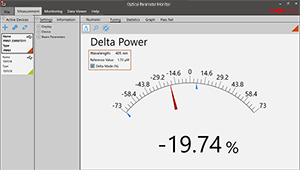
Click to Enlarge
Figure 149B Tuning Mode
Simulated analog needle and digital measurement value provided. Delta Mode, enabled here, shows the fluctuation range during the measurement period.

Click to Enlarge
Figure 149C Statistics Mode
Calculate numerical statistics for a pre-determined measurement period. The panel displays the analyzed values in a bar graph and the results as numerical values.
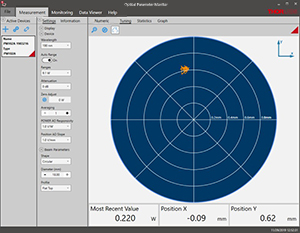
Click to Enlarge
Figure 149D Position Tuning Mode
Tuning mode can be used with a thermal position and power sensor to aid in beam alignment, if the connected power meter supports it.

Click to Enlarge
Figure 149E Position Statistics Mode
Statistics mode also provides aggregate information for thermal position and power sensors, if they are supported.
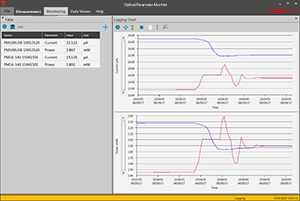
Click to Enlarge
Figure 149F Monitoring Mode
Enable long-term measurement and simultaneous recording from up to eight power meters. Save data as .csv files for later processing while measurement results are displayed in a graph in real time.
PULSE CALCULATIONS
Pulsed Laser Emission: Power and Energy Calculations
Determining whether emission from a pulsed laser is compatible with a device or application can require referencing parameters that are not supplied by the laser's manufacturer. When this is the case, the necessary parameters can typically be calculated from the available information. Calculating peak pulse power, average power, pulse energy, and related parameters can be necessary to achieve desired outcomes including:
- Protecting biological samples from harm.
- Measuring the pulsed laser emission without damaging photodetectors and other sensors.
- Exciting fluorescence and non-linear effects in materials.
Pulsed laser radiation parameters are illustrated in Figure 170A and described in Table 170B. For quick reference, a list of equations is provided below. The document available for download provides this information, as well as an introduction to pulsed laser emission, an overview of relationships among the different parameters, and guidance for applying the calculations.
|
Equations: |
||||
 |
and |  |
||
 |
||||
 |
||||
 |
||||
Peak power and average power calculated from each other: |
||||
 |
and |  |
||
| Peak power calculated from average power and duty cycle*: | ||||
 |
*Duty cycle ( ) is the fraction of time during which there is laser pulse emission. ) is the fraction of time during which there is laser pulse emission. |
|||
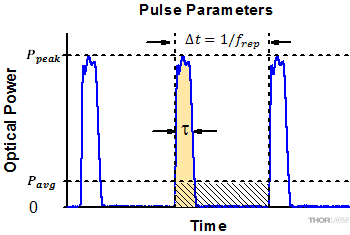
Click to Enlarge
Figure 170A Parameters used to describe pulsed laser emission are indicated in this plot and described in Table 170B. Pulse energy (E) is the shaded area under the pulse curve. Pulse energy is, equivalently, the area of the diagonally hashed region.
| Table 170B Pulse Parameters | |||||
|---|---|---|---|---|---|
| Parameter | Symbol | Units | Description | ||
| Pulse Energy | E | Joules [J] | A measure of one pulse's total emission, which is the only light emitted by the laser over the entire period. The pulse energy equals the shaded area, which is equivalent to the area covered by diagonal hash marks. | ||
| Period | Δt | Seconds [s] | The amount of time between the start of one pulse and the start of the next. | ||
| Average Power | Pavg | Watts [W] | The height on the optical power axis, if the energy emitted by the pulse were uniformly spread over the entire period. | ||
| Instantaneous Power | P | Watts [W] | The optical power at a single, specific point in time. | ||
| Peak Power | Ppeak | Watts [W] | The maximum instantaneous optical power output by the laser. | ||
| Pulse Width |  |
Seconds [s] | A measure of the time between the beginning and end of the pulse, typically based on the full width half maximum (FWHM) of the pulse shape. Also called pulse duration. | ||
| Repetition Rate | frep | Hertz [Hz] | The frequency with which pulses are emitted. Equal to the reciprocal of the period. | ||
Example Calculation:
Is it safe to use a detector with a specified maximum peak optical input power of 75 mW to measure the following pulsed laser emission?
- Average Power: 1 mW
- Repetition Rate: 85 MHz
- Pulse Width: 10 fs
The energy per pulse:

seems low, but the peak pulse power is:

It is not safe to use the detector to measure this pulsed laser emission, since the peak power of the pulses is >5 orders of magnitude higher than the detector's maximum peak optical input power.
RECALIBRATION
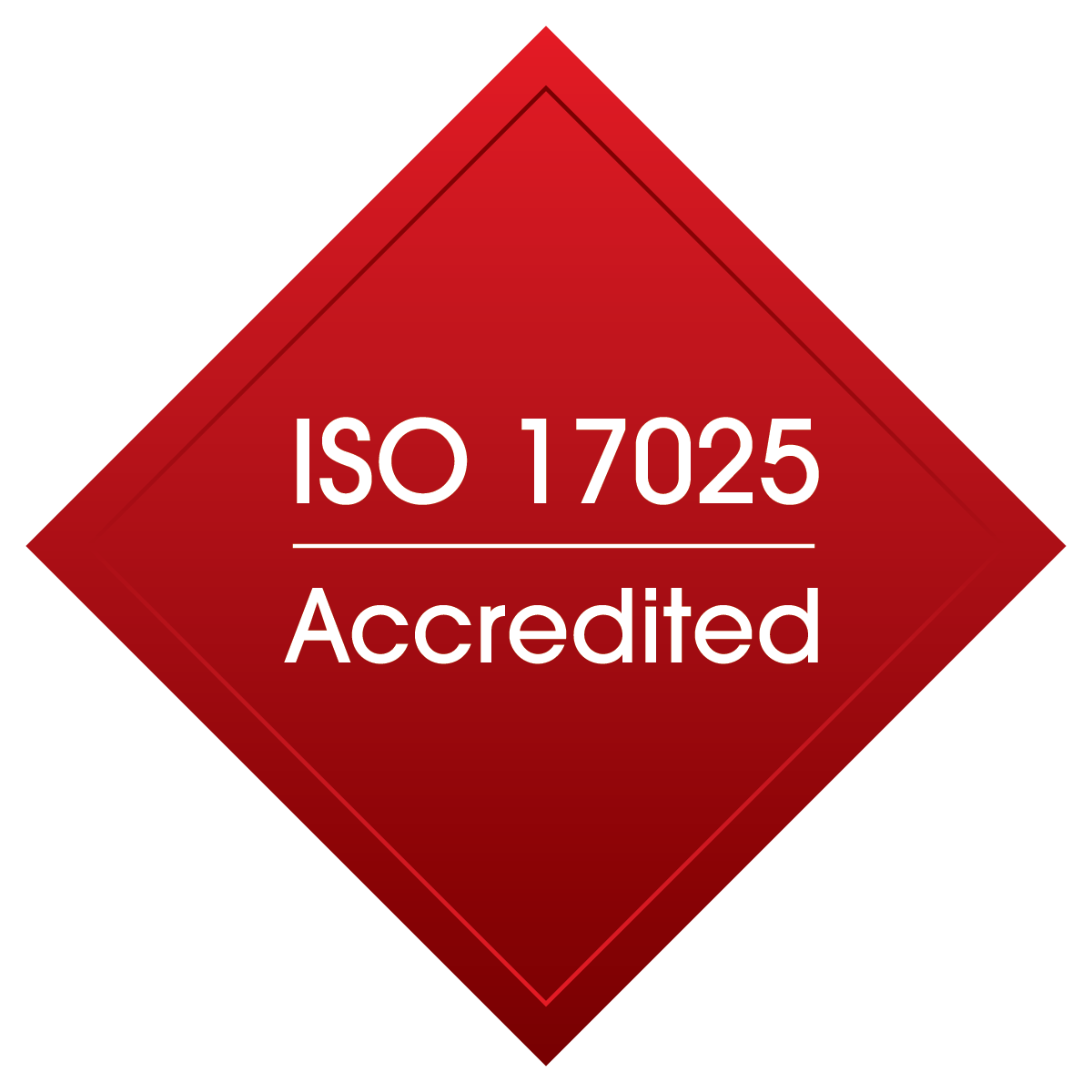
Figure 796A DAkkS-accredited calibrations are performed in accordance with DIN EN ISO/IEC 17025:2018.
Recalibration Services
Thorlabs offers two types of recalibration services in-house for our power and energy meter electronics and photodiode power sensors: ISO 17025 accredited calibrations and manufacturer calibrations. Only the manufacturer calibration is available for the NS170C microscope slide peak power sensor, our thermal power sensors, and our pyroelectric energy sensors. All new products are delivered with a manufacturer calibration by default; if an ISO 17025 accredited calibration is desired for a new device, please contact Tech Sales.
ISO 17025 accredited calibrations are performed in-house in accordance with DIN EN ISO/IEC 17025:2018. Thorlabs GmbH's calibration laboratory is accredited by the German Accreditation Body (DAkkS), the national accreditation authority of the Federal Republic of Germany. The scope of services is described here in English or German. Accredited calibrated power and/or energy meter electronics come with a dedicated certificate of calibration proving the specified accuracy and traceability of calibration data. This certification may be required in certain applications or industries, such as the medical market.
In contrast, our manufacturer calibrations are subject to the quality management requirements of ISO 9001. The certificate of calibration lists the equipment used for the calibration procedure as well as the calibration data acquired. The manufacturer calibration of a power sensor includes recalibration of a single-channel console or interface at no additional cost. If you wish to calibrate one or more sensors with a dual-channel console, each sensor and console calibration service will need to be purchased individually.
Both types of calibration can be offered for third-party equipment or adjusted for special requirements upon request. Please reach out to Tech Sales for further details.
We recommend recalibrating your Thorlabs sensor and console as a pair; however, each may be recalibrated individually. To ensure accurate measurements, we recommend recalibrating annually. To order one or more sensor recalibrations with a dual-channel console, we offer two options: either 1) fill out the Returns Material Authorization (RMA) form with each console and sensor Item # to be recalibrated and specify either manufacturer calibration or ISO 17025 accredited calibration in the "Further Details" field, or 2) separately add each recalibration service Item # offered below to your cart.
Wireless Power Meter with Si Photodiode Sensor
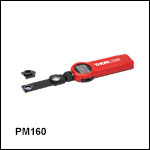
- PM160 Optical Power Meter
- SM05 Adapter
- 1.5 m Long USB Cable w/ USB
Type A and Micro B Connectors - Certificate of Calibration
- Quick Reference User Manual
- Sensor for the 400 - 1100 nm Range
- Measures Optical Powers from 10 nW to 2 mW and up to 200 mW with Sliding Neutral Density (ND) Filter
- Ultra-Slim 3.5 mm Thick Sensor End (6 mm with ND Filter)
- Includes Detachable SM05-Threaded Adapter
The PM160 Wireless Power Meter consists of a sensitive Silicon photodiode connected to a portable power meter with a built-in graphical Organic LED (OLED) display. The Ø9.5 mm (Ø0.37") sensor is designed to detect optical powers between 10 nW and 2 mW at wavelengths between 400 and 1100 nm. The PM160 also comes with a sliding neutral density filter that increases the maximum measurable optical power from 2 mW to 200 mW. The unit automatically detects the position of the neutral density filter to display the correctly calibrated power measurement. To use the filter, simply slide it up the handle until it locks into place over the detector.
Each individual PM160 power meter is calibrated to accurately convert the detected signal to the displayed power reading and a unit-specific calibration certificate is included. To ensure accurate measurements, we recommend recalibrating this power meter annually. In-house recalibration can be ordered using either Item # CAL-PD2 below for a NIST traceable recalibration or Item # CAL-PD2D below for an ISO 17025 accredited calibration.
Three taps compatible with 8-32 and M4 screws allow the power meter to be post mounted in a variety of orientations. The device is shipped with an externally SM05 (0.535"-40) threaded adapter plate that slides over either the filter housing or the end of the sensor arm and snaps into place. When the adapter plate is attached to the sliding ND filter, the entire assembly can still be moved up and down the sensor arm. The external SM05 threads allow other components, such as fiber connector adapters (see Table G1.2), to be attached directly to the PM160. We recommend operating the PM160 wireless power meter in environments between 0 and 50 °C (32 to 122 °F).
Part Number | Description | Price | Availability |
|---|---|---|---|
PM160 | Si Sensor Power Meter with Bluetooth and USB Operation, 400 - 1100 nm, 10 nW - 200 mW | $1,442.68 | Lead Time |
Wireless Power Meter with Thermal Sensor
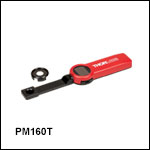
- PM160T Optical Power Meter
- SM1 Adapter w/ MIR Viewing Target
- 0.9 mm (0.035") Hex Key
- 1.5 m Long USB Cable w/ USB
Type A and Micro B Connectors - Certificate of Calibration
- Quick Reference User Manual
- Thermal Sensor for the 190 nm - 10.6 µm Range
- Measures Optical Powers from 100 µW to 2 W
- Ultra-Slim 5.5 mm Thick Sensor End
- Includes Detachable SM1-Threaded Adapter with MIR Viewing Target
The PM160T Wireless Power Meter consists of an ultra-slim thermal sensor connected to a portable power meter with a built-in graphical Organic LED (OLED) display. The Ø10 mm (Ø0.39") sensor is designed to detect optical powers between 100 µW and 2 W at wavelengths between 190 nm and 10.6 µm. The almost flat absorption curve of the detector, maximum power of 2 W, and wavelength range that extends into the MIR make the PM160T well suited for use with a wide variety of broadband and MIR light sources, including LEDs, SLDs, and MIR quantum cascade lasers.
Each individual PM160T power meter is calibrated to accurately convert the detected signal to the displayed power reading and a unit-specific calibration certificate is included. To ensure accurate measurements, we recommend recalibrating this power meter annually. Recalibration can be ordered using Item # CAL-THPY below.
Three universal taps compatible with 8-32 and M4 screws allow the power meter to be post mounted in a variety of orientations. The device is shipped with an externally SM1 (1.035"-40) threaded adapter plate with an MIR viewing target. This target is fabricated from thermochromic liquid crystal material and reacts to light from 1500 nm to over 13.2 µm. To install the adapter, place it over the sensor and secure it by tightening the setscrew with the included 0.9 mm (0.035") hex key. The external SM1 threads allow other components, such as fiber connector adapters (see Table G2.2 for recommendations), to be attached directly to the PM160T. We recommend operating this wireless power meter in environments between 0 and 50 °C (32 to 122 °F).
Part Number | Description | Price | Availability |
|---|---|---|---|
PM160T | Thermal Sensor Power Meter with Bluetooth and USB Operation, 190 nm to 10.6 µm, 100 µW to 2 W | $1,456.66 | Today |
High-Power Wireless Power Meter with Thermal Sensor

- PM160T-HP Optical Power Meter
- External SM1 Thread Adapter
- 1.5 m Long USB Cable w/ USB
Type A and Micro B Connectors - Certificate of Calibration
- Quick Reference User Manual
- Thermal Sensor for the 190 nm - 20 µm Range
- Measures Optical Powers from 10 mW to 70 W
- Slim 13.0 mm Thick Sensor End
- Includes Externally SM1-Threaded (1.035"-40) Adapter for Compatibility with Fiber Adapters
The PM160T-HP Wireless Power Meter consists of a slim thermal sensor connected to a portable power meter with a built-in graphical Organic LED (OLED) display. The Ø25.2 mm sensor is designed to detect optical powers between 10 mW and 70 W at wavelengths between 190 nm and 20 µm. The almost flat absorption curve of the detector, maximum power of 70 W, and wavelength range that extends into the MIR make the PM160T-HP well suited for use with a wide variety of broadband and MIR light sources, including LEDs, SLDs, and MIR quantum cascade lasers.
Each individual PM160T-HP power meter is calibrated to accurately convert the detected signal to the displayed power reading and a unit-specific calibration certificate is included. To ensure accurate measurements, we recommend recalibrating this power meter annually. Recalibration can be ordered using Item # CAL-THPY below.
Three universal taps compatible with 8-32 and M4 screws allow the power meter to be post mounted in a variety of orientations. The device is shipped with an externally SM1 (1.035"-40) threaded adapter. To install the adapter, screw it into the internal SM1 threads on the sensor housing. The external SM1 threads allow other components, such as fiber connector adapters (see Table G3.2 for recommendations), to be attached directly to the PM160T-HP. We recommend operating this wireless power meter in environments between 0 and 50 °C (32 to 122 °F).
Part Number | Description | Price | Availability |
|---|---|---|---|
PM160T-HP | Thermal Sensor Power Meter with Bluetooth and USB Operation, 190 nm to 20 µm, 10 mW to 70 W | $1,557.68 | Today |
In-House Recalibration Services for Wireless Power Meters
| Table G4.1 Calibration Compatibility | |
|---|---|
| Calibration Service Item # | Compatible Power Meter |
| CAL-PD2 or CAL-PD2D | PM160 |
| CAL-THPY | PM160T, PM160T-HP |
Thorlabs offers recalibration services for our wireless power meters. To ensure accurate measurements, we recommend recalibrating power meters annually.
Refer to Table G4.1 for the appropriate calibration service Item # that corresponds to your power meter. For Item # PM160, we offer two types of recalibration: a manufacturer calibration (Item # CAL-PD2) or an ISO 17025 accredited calibration (Item # CAL-PD2D). ISO 17025 accredited calibrations are performed in accordance with DIN EN ISO/IEC 17025:2018. Thorlabs GmbH's calibration laboratory is accredited by the German Accreditation Body (DAkkS), the national accreditation authority of the Federal Republic of Germany. The scope of services is described here in English or German. For more details on these recalibration services, please see the Recalibration tab or click the Documents (![]() ) icons below.
) icons below.
Requesting a Calibration
Thorlabs provides two options for requesting a calibration:
- Complete the Returns Material Authorization (RMA) form. When completing the RMA form, please enter your name, contact information, the Part #, and the Serial # of the item being returned for calibration; in the Reason for Return field, select "I would like an item to be calibrated." For calibrating Item # PM160, please specify in the Further Details field whether you would like the manufacturer calibration or the ISO 17025 accredited calibration. Once the form has been submitted, a member of our RMA team will reach out to provide an RMA Number, return instructions, and to verify billing and payment information.
- Select the appropriate calibration Item # from Table G4.1, enter the Part # and Serial # of the sensor that requires recalibration, and then Add to Cart. A member of our RMA team will reach out to coordinate return of the item for calibration. Should you have other items in your cart, note that the calibration request will be split off from your order for RMA processing.
Please Note: To ensure your item being returned for calibration is routed appropriately once it arrives at our facility, please do not ship it prior to being provided an RMA Number and return instructions by a member of our team.
Part Number | Description | Price | Availability |
|---|---|---|---|
CAL-PD2 | Manufacturer Recalibration Service for Dual-Power-Range Silicon Photodiode Power Sensors | $208.47 | Lead Time |
CAL-PD2D | ISO 17025 Accredited Calibration Service for Dual-Power-Range Silicon Photodiode Power Sensors | $531.30 | Lead Time |
CAL-THPY | Recalibration Service for Thermal Power and Pyroelectric Energy Sensors at 1064 nm | $227.50 | Lead Time |


